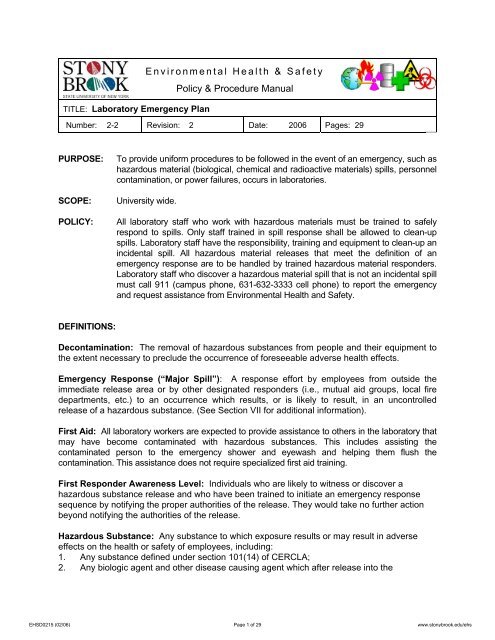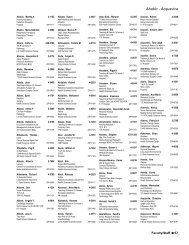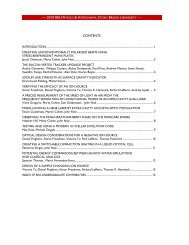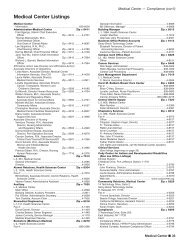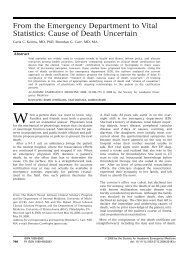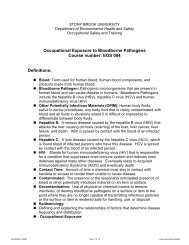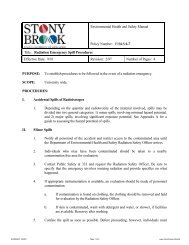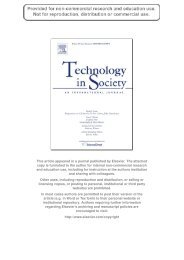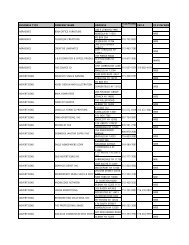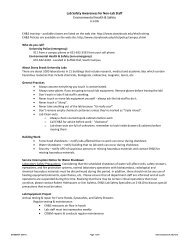Laboratory Emergency Spill Plan - Stony Brook University
Laboratory Emergency Spill Plan - Stony Brook University
Laboratory Emergency Spill Plan - Stony Brook University
Create successful ePaper yourself
Turn your PDF publications into a flip-book with our unique Google optimized e-Paper software.
Environmental Health & Safety<br />
Policy & Procedure Manual<br />
TITLE: <strong>Laboratory</strong> <strong>Emergency</strong> <strong>Plan</strong><br />
Number: 2-2 Revision: 2 Date: 2006 Pages: 29<br />
PURPOSE:<br />
SCOPE:<br />
POLICY:<br />
To provide uniform procedures to be followed in the event of an emergency, such as<br />
hazardous material (biological, chemical and radioactive materials) spills, personnel<br />
contamination, or power failures, occurs in laboratories.<br />
<strong>University</strong> wide.<br />
All laboratory staff who work with hazardous materials must be trained to safely<br />
respond to spills. Only staff trained in spill response shall be allowed to clean-up<br />
spills. <strong>Laboratory</strong> staff have the responsibility, training and equipment to clean-up an<br />
incidental spill. All hazardous material releases that meet the definition of an<br />
emergency response are to be handled by trained hazardous material responders.<br />
<strong>Laboratory</strong> staff who discover a hazardous material spill that is not an incidental spill<br />
must call 911 (campus phone, 631-632-3333 cell phone) to report the emergency<br />
and request assistance from Environmental Health and Safety.<br />
DEFINITIONS:<br />
Decontamination: The removal of hazardous substances from people and their equipment to<br />
the extent necessary to preclude the occurrence of foreseeable adverse health effects.<br />
<strong>Emergency</strong> Response (“Major <strong>Spill</strong>”): A response effort by employees from outside the<br />
immediate release area or by other designated responders (i.e., mutual aid groups, local fire<br />
departments, etc.) to an occurrence which results, or is likely to result, in an uncontrolled<br />
release of a hazardous substance. (See Section VII for additional information).<br />
First Aid: All laboratory workers are expected to provide assistance to others in the laboratory that<br />
may have become contaminated with hazardous substances. This includes assisting the<br />
contaminated person to the emergency shower and eyewash and helping them flush the<br />
contamination. This assistance does not require specialized first aid training.<br />
First Responder Awareness Level: Individuals who are likely to witness or discover a<br />
hazardous substance release and who have been trained to initiate an emergency response<br />
sequence by notifying the proper authorities of the release. They would take no further action<br />
beyond notifying the authorities of the release.<br />
Hazardous Substance: Any substance to which exposure results or may result in adverse<br />
effects on the health or safety of employees, including:<br />
1. Any substance defined under section 101(14) of CERCLA;<br />
2. Any biologic agent and other disease causing agent which after release into the<br />
EHSD0215 (02/06) Page 1 of 29 www.stonybrook.edu/ehs
TITLE: <strong>Laboratory</strong> <strong>Emergency</strong> <strong>Plan</strong> POLICY: 2-2<br />
environment and upon exposure, ingestion, inhalation, or assimilation into any person,<br />
either directly from the environment or indirectly by ingestion through food chains, will or<br />
may reasonably be anticipated to cause death, disease, behavioral abnormalities, cancer,<br />
genetic mutation, physiological malfunctions (including malfunctions in reproduction) or<br />
physical deformations in such persons or their offspring.<br />
3. Any substance listed by the U.S. Department of Transportation as hazardous materials<br />
under 49 CFR 172.101 and appendices; and<br />
4. Hazardous waste.<br />
Health Hazard: Includes chemicals which are carcinogens, toxic or highly toxic agents,<br />
reproductive toxins, irritants, corrosives, sensitizers, hepatotoxins, nephrotoxins, neurotoxins,<br />
agents which act on the hematopoietic system and agents which damage the lungs, skin, eyes,<br />
or mucous membranes. It also includes hazards due to temperature extremes.<br />
IDLH or Immediately Dangerous to Life or Health: An atmospheric concentration of any<br />
toxic, corrosive or asphyxiant substance that poses an immediate threat to life or would interfere<br />
with an individual's ability to escape from a dangerous atmosphere.<br />
Incidental Release (“Minor <strong>Spill</strong>”): The hazardous substance can be absorbed, neutralized, or<br />
otherwise controlled at the time of release by employees in the immediate release area, or by<br />
maintenance personnel. Responses to releases of hazardous substances where there is no<br />
potential safety or health hazard (i.e., fire, explosion, or chemical exposure) are not considered to<br />
be emergency responses and are incidental releases. See Section VII for more information.<br />
<strong>Laboratory</strong> Staff: <strong>Laboratory</strong> employees, users, volunteers and visitors who perform multiple<br />
chemical procedures on a regular or periodic basis with containers used for reactions, transfers,<br />
and other handling of substances designed to be easily and safety manipulated by one person and<br />
protective laboratory practices and equipment are available and in common use to minimize the<br />
potential for employee exposure to hazardous chemicals. This includes laboratory technicians,<br />
instructors, researchers, graduate assistants, student aides, part-time and temporary employees.<br />
These employees must also comply with EH&S Policy 4-2 Chemical Hygiene <strong>Plan</strong>.<br />
NFPA/HMIS Ratings: The NFPA label system was designed for emergency response personnel<br />
and provides a quick system to identify the relative danger (0 – 4) associated with a hazardous<br />
material (NFPA 704). This system does not provide the user with specific health hazard information.<br />
The HMIS system is similar.<br />
-Rev. 2006-<br />
EHSD0215 (02/06) Page 2 of 29 www.stonybrook.edu/ehs
TITLE: <strong>Laboratory</strong> <strong>Emergency</strong> <strong>Plan</strong> POLICY: 2-2<br />
PROCEDURES:<br />
I. Emergencies - General<br />
For emergencies such as fires, explosions, spills or transportation accidents, the basic<br />
protocol is:<br />
1. Rescue anyone immediately affected by the emergencies only if it does not put you at<br />
risk.<br />
2. Notify the proper authorities:<br />
a. If the emergency involves a fire, use the manual pull box to activate the alarm.<br />
b. For other emergencies, contact <strong>University</strong> Police at 911 from any campus phone (or<br />
631-632-3333 from a cell phone), and describe the emergency. Request the<br />
Hazardous Materials Response Team (HAZMAT) for chemical emergencies and the<br />
Radiation Protection Officer if radiological materials are involved.<br />
3. Provide first aid to victims. This includes assisting contaminated staff with the<br />
emergency shower or eyewash station.<br />
4. Warn others in the area about the emergency by posting a notice (see Appendix 5), and<br />
stay clear of the area. Account for all laboratory staff to ensure that no one was left<br />
behind during the evacuation.<br />
5. Follow the directions of the <strong>Emergency</strong> Responders (i.e. Fire Department personnel,<br />
Department of Environmental Health and Safety personnel).<br />
II.<br />
Responsibilities:<br />
A. Supervisors, PIs, etc. must:<br />
1. Ensure that all lab workers have appropriate spill clean up procedure training.<br />
2. Ensure that appropriate Personal Protective Equipment (PPE) is available.<br />
3. Ensure that appropriate spill control material is readily available for the hazardous<br />
substances used in the work area, and everyone knows how to use it (see Appendix 3<br />
for guidelines).<br />
4. Ensure spills are reported to EH&S.<br />
B. <strong>Laboratory</strong> Staff must:<br />
1. Attend training.<br />
2. Follow appropriate work practices to prevent spills.<br />
3. Clean up all incidental spills.<br />
4. Notify others, begin evacuation and contact <strong>University</strong> Police and request HAZMAT for<br />
<strong>Emergency</strong> Response.<br />
5. Seek Medical Attention for all personal contamination.<br />
6. Properly dispose of clean-up material from any incidental response involving hazardous<br />
materials.<br />
-Rev. 2006-<br />
EHSD0215 (02/06) Page 3 of 29 www.stonybrook.edu/ehs
TITLE: <strong>Laboratory</strong> <strong>Emergency</strong> <strong>Plan</strong> POLICY: 2-2<br />
7. Report all minor spills to EH&S after the laboratory staff has cleaned up material.<br />
C. Environmental Health and Safety will:<br />
1. Provide spill control training.<br />
2. Provide guidance on spill control equipment, including personal protective equipment<br />
(PPE).<br />
3. Respond to calls from campus community requesting guidance with spill response.<br />
4. Make determination on whether to handle clean up within EH&S resources or to contact<br />
external Response Team.<br />
5. Investigate spills and recommend corrective actions to prevent reoccurrences.<br />
6. Arrange for disposal of all spill clean-up material.<br />
III.<br />
Training<br />
1. All laboratory staff must be trained to clean incidental spills of hazardous materials.<br />
2. All laboratory staff must be trained to the First Responder Awareness Level. At the end of<br />
the training, they will be able to demonstrate competency in the following areas:<br />
a. An understanding of what hazardous substances are, and the risks associated with<br />
them in an incident.<br />
b. An understanding of the potential outcomes associated with an emergency created<br />
when hazardous substances are present.<br />
c. The ability to recognize the presence of hazardous substances in an emergency.<br />
d. The ability to identify the hazardous substances, if possible.<br />
e. An understanding of the role of the first responder awareness individual in the<br />
employer's emergency response plan including site security and control and the<br />
U.S. Department of Transportation's <strong>Emergency</strong> Response Guidebook.<br />
f. The ability to realize the need for additional resources, and to make appropriate<br />
notifications to the communication center.<br />
3. Training must be completed prior to working with hazardous materials and an annual<br />
refresher to demonstrate competency in the above areas is required.<br />
4. Training will be provided by EH&S.<br />
IV.<br />
<strong>Emergency</strong> Pre-<strong>Plan</strong><br />
Each laboratory must prepare an emergency plan and all personnel should be familiar with it. This<br />
emergency plan should include:<br />
1. An inventory that includes the quantities and locations of all flammable, pyrophoric,<br />
oxidizing, toxic, corrosive, reactive, radioactive materials, nonionizing radiation, biological<br />
materials, and compressed and liquefied gases.<br />
2. A list of responsible personnel who are designated and trained to be liaison personnel for<br />
the fire department or other emergency responders.<br />
3. Action to be taken by laboratory personnel upon activation of the fire alarm. This should<br />
include instructions to turn off flames and other ignition sources, close the fume hood sash,<br />
-Rev. 2006-<br />
EHSD0215 (02/06) Page 4 of 29 www.stonybrook.edu/ehs
TITLE: <strong>Laboratory</strong> <strong>Emergency</strong> <strong>Plan</strong> POLICY: 2-2<br />
close all hazardous materials containers, and turn off all electrical equipment. All staff are<br />
required to exit the building when the fire alarm is activated.<br />
4. Location of emergency equipment in the laboratory (fire extinguishers, emergency shower,<br />
eyewash, spill kit and fire blanket if available).<br />
5. Procedures for extinguishing clothing fires (stop, drop & roll, cover face with hands and use<br />
fire blanket, do not use fire extinguisher), using emergency shower and eyewash and spill<br />
kits.<br />
6. Primary and secondary evacuation routes to the outside of the building. The 2 closest<br />
emergency exits to the laboratory need to be identified prior to any emergency.<br />
7. Identify an area outside of the building to meet and account for all laboratory personnel.<br />
8. Instructions not to reenter the building until qualified <strong>Emergency</strong> Responders provide<br />
notification that it is safe to return.<br />
See Appendix 2 for <strong>Laboratory</strong> <strong>Emergency</strong> <strong>Plan</strong> Template.<br />
V. <strong>Spill</strong> Control Equipment<br />
All laboratories must have spill control equipment. Commercial spill kits can be purchased or the<br />
necessary components assembled in the lab. All laboratory staff must know where the spill control<br />
equipment is kept and be instructed on how to use it. Cleanup materials must be sufficient to<br />
contain the hazard type and volume of materials being used in the laboratory. The spill control<br />
equipment must be regularly checked by the laboratory staff and restocked after use.<br />
1. Basic Equipment<br />
a. <strong>Spill</strong> Warning Sign (Appendix 5)<br />
b. First Aid kit<br />
• General Contents: bandages, compresses, tape, gloves, antiseptic and burn<br />
treatments.<br />
• Hydrofluoric Acid use requires “antidote” gel in lab. Train all HF users. Check<br />
expiration date. Pharmascience calcium gluconate. http://cagluconate.com<br />
c. Absorbent pads, vermiculite, and/or kitty litter<br />
d. Plastic dust pan, scoop and broom<br />
e. Plastic bags; Hazardous Waste labels<br />
2. Material Specific <strong>Spill</strong> Control Equipment (see Appendix 3 for more detailed information):<br />
a. Flammable Solvents<br />
b. Mercury<br />
c. Hydrofluoric Acid<br />
d. Acid/Base<br />
e. Formaldehyde<br />
f. Osmium Tetroxide<br />
g. Blood/Body Fluid<br />
h. Radioactive Material Decontamination<br />
• Products such as RadCon Surface Cleaner, RadCon Hand Cleaner, (VWR),<br />
Decon NoCount Surface Cleaner or Decon NoCount Hand and Skin Cleaner<br />
-Rev. 2006-<br />
EHSD0215 (02/06) Page 5 of 29 www.stonybrook.edu/ehs
TITLE: <strong>Laboratory</strong> <strong>Emergency</strong> <strong>Plan</strong> POLICY: 2-2<br />
(Fisher)<br />
3. Personal Protective Equipment<br />
a. Gloves: gloves must be appropriate for the hazardous material that is being cleaned<br />
up.<br />
b. Goggles: eye protection must be appropriate for the hazardous material that is being<br />
cleaned up. Chemical splash goggles must be worn for chemical spills. A face shield<br />
may be needed and must be worn over chemical splash goggles.<br />
c. Respirator: only staff who have been medically cleared to wear a respirator, fit<br />
tested and trained on the use and limitations of the respiratory protection equipment<br />
(annual requirements) can wear a respirator. The respirator must be selected for the<br />
hazard and potential exposure of the spilled hazardous material. All respiratory<br />
protection use must be coordinated with EH&S. Contact EH&S for assistance and<br />
guidance.<br />
VI. Medical Consultation<br />
The employer (Department or Supervisor) shall provide all employees who work with hazardous<br />
chemicals an opportunity to receive medical attention, including any follow-up examinations<br />
which the examining physician determines to be necessary whenever an event takes place in<br />
the work area such as a spill, leak, explosion or other occurrence resulting in the likelihood of a<br />
hazardous exposure, the affected employee shall be provided an opportunity for a medical<br />
consultation. Such consultation shall be for the purpose of determining the need for a medical<br />
examination. All medical examinations and consultations shall be performed by or under the<br />
direct supervision of a licensed physician and shall be provided without cost to the employee,<br />
without loss of pay and at a reasonable time and place.<br />
A. Information provided to the physician<br />
The employer (Department or Supervisor) shall provide the following information to the<br />
physician:<br />
1. The identity of the hazardous chemical(s) to which the employee may have been<br />
exposed;<br />
2. A description of the conditions under which the exposure occurred including quantitative<br />
exposure data, if available; and<br />
3. A description of the signs and symptoms of exposure that the employee is experiencing,<br />
if any.<br />
B. Physician's written opinion<br />
For examination or consultation required in this policy, the Department or Supervisor shall<br />
obtain a written opinion from the examining physician which shall include the following:<br />
1. Any recommendation for further medical follow-up;<br />
2. The results of the medical examination and any associated tests;<br />
3. Any medical condition which may be revealed in the course of the examination which<br />
may place the employee at increased risk as a result of exposure to a hazardous<br />
workplace; and<br />
-Rev. 2006-<br />
EHSD0215 (02/06) Page 6 of 29 www.stonybrook.edu/ehs
TITLE: <strong>Laboratory</strong> <strong>Emergency</strong> <strong>Plan</strong> POLICY: 2-2<br />
4. A statement that the employee has been informed by the physician of the results of the<br />
consultation or medical examination and any medical condition that may require further<br />
examination or treatment.<br />
5. The written opinion shall not reveal specific findings of diagnoses unrelated to<br />
occupational exposure.<br />
This written opinion must be made part of the employee’s official personnel file and be retained for<br />
at least the duration of employment plus thirty (30) years (29 CFR 1910.1020 Access to Employee<br />
Exposure and Medical Records).<br />
VII.<br />
Determination of Major vs. Minor <strong>Spill</strong><br />
To determine whether a spill is major (emergency response with clean up by outside staff) or<br />
minor (incidental release with clean up by lab staff), you need to know (1) the hazard(s) posed<br />
by the spilled chemical and (2) the spill's potential impact. Both these factors are, in large part,<br />
determined by the spill's size. The following information will help you determine whether you<br />
have a minor spill and can be cleaned up by the lab staff:<br />
• the type of chemical(s) spilled – are there any other hazards besides the chemical<br />
(biological or radioactive)?<br />
• the amount,<br />
• the hazardous characteristics of the spilled chemical(s) – is it a solid, powder, liquid or<br />
gas? Is it flammable, corrosive or toxic?<br />
• the location,<br />
• the proper method for cleaning up the spill,<br />
• the personal protective equipment available, and<br />
• the training of the laboratory's personnel.<br />
• A chemical spill is not a health risk if it has a low toxicity (especially if it is not volatile or<br />
a dust), is not highly corrosive, and is not a strong oxidizer. Such spills may be<br />
considered "minor" only if physical damage or environmental factors are absent.<br />
• If the spilled chemical's toxicity is unknown, treat the spill like a potential human health<br />
hazard by avoiding exposure and seeking outside assistance.<br />
Factors that may magnify a spill's impact and require emergency response (major spill) are:<br />
• the possibility that hazardous vapors or dusts might enter the building's ventilation<br />
system and be distributed to other areas;<br />
• the possibility that spilled liquids might flow into other areas, thus expanding the threat of<br />
harm, such as reaching ignition sources, exposing other people, damaging delicate<br />
equipment;<br />
• the presence of incompatible chemicals;<br />
• the proximity of classrooms or offices containing people who could be harmed by the<br />
spill's consequences; and<br />
• spills in sinks that might be connected to other sinks through the plumbing system.<br />
A Major <strong>Spill</strong> is one in which the following occurs:<br />
-Rev. 2006-<br />
EHSD0215 (02/06) Page 7 of 29 www.stonybrook.edu/ehs
TITLE: <strong>Laboratory</strong> <strong>Emergency</strong> <strong>Plan</strong> POLICY: 2-2<br />
1. The response comes from outside the immediate release area.<br />
2. The release requires evacuation of employees in the area.<br />
3. The release poses, or has the potential to pose, conditions that are immediately dangerous<br />
to life and health (IDLH).<br />
4. The release poses a serous threat of fire or explosion (exceeds or has the potential to<br />
exceed the lower explosive limit or lower flammable limit).<br />
5. The release requires immediate attention because of imminent danger.<br />
6. The release may cause high levels of exposure to toxic substances.<br />
7. There is uncertainty that the employee in the work area can handle the severity of the<br />
hazard with the PPE and equipment that has been provided ant the exposure limit could<br />
easily be exceeded.<br />
8. The situation is unclear, or data are lacking on important factors. The properties of<br />
hazardous substances, such as toxicity, volatility, flammability, explosiveness,<br />
corrosiveness, etc. as well as the particular circumstances of the release itself, such as<br />
quantity, confined space considerations, ventilation, etc. must be known and understood<br />
prior to response.<br />
In addition to potential fire and explosion hazards, strong corrosives and oxidizers typically fall<br />
under the property damage category. A large-quantity release that threatens the environment is not<br />
a minor spill, but requires the attention of trained responders. If any hazards are present that would<br />
damage property or the environment, treat the spill as “large” or “major” and contact <strong>University</strong><br />
Police at 911 from a campus phone (631-632-3333 from cell phone).<br />
A minor spill is:<br />
• Less than 1 gallon spill of a low toxicity or non flammable chemical or a material that has<br />
any NFPA/HMIS rating of 1 or 2;<br />
• A spill involving less than 20 cc/ml of a particularly hazardous chemical (carcinogen,<br />
reproductive hazard or acutely toxic), or chemical with any NFPA/HMIS rating or 3 or 4;<br />
• Blood and/or body fluids<br />
• Any amount of chemical material with all NFPA/HMIS ratings of 0<br />
NFPA<br />
Rating<br />
Health Hazard<br />
(BLUE)<br />
Fire Hazard<br />
(RED)<br />
Instability (Reactivity) Hazard<br />
(YELLOW)<br />
0 Normal Will not burn Stable<br />
1 Slightly Hazardous Flash Point above 200 o F Unstable if heated<br />
2 Hazardous Flash Point below 200 o F Violent chemical change<br />
3 Extreme Danger Flash Point below 100 o F Shock & heat may detonate<br />
4 Deadly Flash Point below 73 o F May detonate<br />
http://www.hazmat.msu.edu:591/nfpa/ for NFPA ratings<br />
-Rev. 2006-<br />
EHSD0215 (02/06) Page 8 of 29 www.stonybrook.edu/ehs
TITLE: <strong>Laboratory</strong> <strong>Emergency</strong> <strong>Plan</strong> POLICY: 2-2<br />
VIII.<br />
Biohazard <strong>Spill</strong>s in the <strong>Laboratory</strong><br />
A. Employee Contamination<br />
1. If the skin becomes contaminated with blood or other potentially infectious materials,<br />
wash the area thoroughly with soap and water.<br />
2. If blood or other potentially infectious material is splashed into the eyes, immediately<br />
use the eyewash station, and flush for at least 15 minutes.<br />
3. Remove grossly contaminated clothing immediately. Place the contaminated clothing in<br />
a plastic bag.<br />
4. Report the spill to the Supervisor, and seek medical attention.<br />
5. File an incident report with your department. Specific OSHA paperwork is required for<br />
bloodborne pathogens exposure. See Occupational Exposure to Bloodborne<br />
Pathogens, EH&S Policy 1-4 (http://www.stonybrook.edu/facilities/ehs/policy/EHS_1-<br />
4.pdf) for specific information.<br />
B. Clean Up<br />
1. Wear the appropriate personal protective equipment (PPE) to clean up the spill. At a<br />
minimum, this includes gloves, protective eyewear and a mask, or a faceshield.<br />
Depending on the size and type of spill, impervious gowns, protective foot coverings, or<br />
respirators may be needed.<br />
2. Pick up any broken glass with tongs or some other mechanical device. Do not use your<br />
hands.<br />
3. Place absorbent towels over the spill, making sure not to spread the liquid.<br />
4. Carefully pour a dilute bleach solution (1:10) or other EPA registered tuberculocidal<br />
agent over the absorbent towels. Let this remain for 10 minutes in order to disinfect the<br />
spill.<br />
5. Carefully pick up the absorbent towels, and place into a plastic bag. Wash the<br />
contaminated area again with the bleach other disinfectant. Rinse the area with water.<br />
6. All PPE, towels, and other items that became contaminated must be disposed of a<br />
regulated medical waste.<br />
7. Wash hands and any other exposed skin with soap and water before leaving the work<br />
area.<br />
C. <strong>Spill</strong>s or Breakage in a Centrifuge<br />
1. Turn off the centrifuge, and allow it to come to a full stop before opening the cover.<br />
2. Wear the appropriate PPE to clean the spill.<br />
3. Remove any broken glass with tongs, and clean the spill as outlined above.<br />
D. <strong>Spill</strong>s in a Biological Safety Cabinet or Laminar Flow Hood<br />
1. Do not shut off the ventilation. The cabinet should be left running to prevent the escape<br />
of contaminants. If there is a UV light, leave it on.<br />
-Rev. 2006-<br />
EHSD0215 (02/06) Page 9 of 29 www.stonybrook.edu/ehs
TITLE: <strong>Laboratory</strong> <strong>Emergency</strong> <strong>Plan</strong> POLICY: 2-2<br />
2. Wear the appropriate PPE. If the material is infectious, a respirator may be needed.<br />
Contact the Department of Environmental Health and Safety for additional information.<br />
3. Use a diluted bleach solution (1:10) or an EPA registered tuberculocidal agent to<br />
disinfect the cabinet. Wipe the walls, work surfaces, and equipment with the<br />
disinfectant. Use sufficient amount of the disinfectant to ensure that the drain pans and<br />
catch basins below the work surface get disinfected. Lift the front exhaust grill and tray<br />
and wipe all surfaces. Let the disinfectant stand for 10 minutes. Wipe the catch basin<br />
and drain the disinfectant into a container. Wipe the area with water.<br />
4. This procedure will not disinfect the filters, blowers, air ducts, or other interior parts of<br />
the cabinet. If the cabinet is to be sterilized, contact the Department of Environmental<br />
Health and Safety for additional information.<br />
IX.<br />
Chemical <strong>Spill</strong>s<br />
A. Employee Contamination<br />
1. Call 911 (campus phone, 631-632-3333 cell phone) to report the spill and request<br />
assistance from EH&S.<br />
2. Assist victim with appropriate first aid and move to fresh air.<br />
a. DO NOT become contaminated by the chemical as you give first aid.<br />
b. DO NOT try to neutralize any chemical.<br />
c. DO NOT disturb a blister or remove dead skin from a chemical burn.<br />
d. DO NOT apply any household remedy such as an ointment or salve to a chemical<br />
burn.<br />
3. If the skin becomes contaminated with hazardous materials, wash the affected area<br />
thoroughly with copious amounts of water. If available, use the <strong>Emergency</strong> Shower for<br />
at least 15 minutes.<br />
4. If hazardous material is splashed into the eyes, immediately use the eyewash station,<br />
and flush for at least 15 minutes.<br />
5. Remove grossly contaminated clothing, including shoes, immediately. Place the<br />
contaminated clothing in a plastic bag.<br />
6. Report the spill to the Supervisor, and seek medical attention.<br />
7. File an incident report with your department.<br />
B. Small Chemical <strong>Spill</strong> Clean Up – Incidental <strong>Spill</strong><br />
1. These spills can be cleaned up by trained laboratory personnel.<br />
Examples:<br />
a. Less than 1 gallon spill of a low toxicity or non flammable chemical or a material<br />
that has any NFPA/HMIS rating of 1 or 2;<br />
b. A spill involving less than 20 cc/ml of a particularly hazardous chemical<br />
(carcinogen, reproductive hazard or acutely toxic), or chemical with any<br />
NFPA/HMIS rating or 3 or 4;<br />
c. Blood and/or body fluids<br />
d. Any amount of chemical material with all NFPA/HMIS ratings of 0<br />
-Rev. 2006-<br />
EHSD0215 (02/06) Page 10 of 29 www.stonybrook.edu/ehs
TITLE: <strong>Laboratory</strong> <strong>Emergency</strong> <strong>Plan</strong> POLICY: 2-2<br />
2. Notify fellow workers in vicinity of spill.<br />
3. Secure area by restricting access and posting signs.<br />
4. Wear the appropriate personal protective equipment (PPE) to clean up the spill. At a<br />
minimum, this includes gloves and protective eyewear (chemical splash goggles).<br />
Depending on the size and type of spill, protective clothing (lab coat and apron), and<br />
protective foot coverings may be needed. If high splash potential exists, also wear a<br />
face shield over the chemical splash goggles.<br />
5. Shutdown equipment:<br />
a. Close doors and shut HVAC vents if possible.<br />
b. Close all chemical containers.<br />
c. Close fume hood sash (leave fume hood ON).<br />
d. Turn off heating devices.<br />
e. Stop any reactions in progress.<br />
f. If flammable material spills, turn off sources of heat and ignition in entire lab.<br />
6. Gather and review safety information on spilled chemical. Review chemical’s<br />
Material Safety Data Sheet (MSDS) for a hazard assessment and other pertinent<br />
information. Important information to know before beginning clean up includes:<br />
a. Flammability: Flash Point and Vapor Pressure<br />
b. Toxicity: PEL, TLV<br />
c. Corrosiveness: pH<br />
7. Locate an appropriate spill kit.<br />
8. Pick up any broken glass with tongs, dust pan and broom, or some other mechanical<br />
device. Do not use your hands to pick up the broken glass. Dispose of glass in an<br />
appropriate container (e.g. heavy cardboard box which is taped shut and marked<br />
“BROKEN GLASS” prior to disposal).<br />
9. Confine and contain spill. Place absorbent material over the spill, making sure not to<br />
spread the liquid. Protect drains – do not allow any spilled material to enter drains.<br />
a. Liquid <strong>Spill</strong>s:<br />
i. Cover spill material with absorbent. Work from outside to center of spill to<br />
avoid spreading liquid.<br />
b. Flammable Solvents:<br />
i. Immediately turn off any open flames, heating devices, instrument or<br />
machine near the spill that could spark and cause the solvent vapors to<br />
ignite and flash back.<br />
ii. Use plastic scoops and dust pan to clean up absorbent material.<br />
c. Acids (except HF)<br />
i. It is not necessary to neutralize an incidental spill. Use absorbent material.<br />
ii. Decontaminate area after removal of absorbent. Check pH if possible.<br />
d. Powder <strong>Spill</strong>s:<br />
i. Do not dry sweep material. This will cause powder to become airborne and<br />
spread. Thoroughly wet material with water (or appropriate material) first.<br />
e. Alkali Metals<br />
i. Smother with dry sand. Avoid contact with water.<br />
ii. Do not dry sweep material.<br />
f. Mercury<br />
-Rev. 2006-<br />
EHSD0215 (02/06) Page 11 of 29 www.stonybrook.edu/ehs
TITLE: <strong>Laboratory</strong> <strong>Emergency</strong> <strong>Plan</strong> POLICY: 2-2<br />
i. Cover with mercury decontaminating powder.<br />
ii. Do not dry sweep material. Use aspirator bulb or wet paper towels to collect<br />
mercury beads.<br />
iii. Use a flashlight to detect mercury beads that may have spread.<br />
g. Gas Leak<br />
i. Turn off gas cylinder if possible.<br />
ii. If gas is toxic, corrosive or flammable, evacuate area and call <strong>University</strong><br />
Police at 911.<br />
10. Clean up spill using a scoop or other suitable item and place material in appropriate<br />
disposal container.<br />
11. Decontaminate spill surface with mild detergent and water, as appropriate. Carefully<br />
remove PPE, place non-reusable items in disposal container and thoroughly wash<br />
hands.<br />
12. Dispose of all contaminated material in a plastic bag. Label the bag with the name of the<br />
hazardous material. Complete a hazardous waste label and affix label to container.<br />
Contact the Department of Environmental Health and Safety for disposal.<br />
13. Investigate cause of spill and review with EH&S. Document spill, response and followup<br />
with staff. The incident report must include the following:<br />
a. Type of emergency<br />
b. Name of material spilled, including pH, strength, concentration, etc.<br />
c. Area of spill and estimate of volume<br />
d. Remediation performed<br />
e. Any follow-up that may be necessary<br />
f. Contact person<br />
g. Names of people who may have been exposed to substance<br />
14. Replenish spill kit.<br />
C. Large Chemical <strong>Spill</strong> Clean Up – <strong>Emergency</strong> Response<br />
1. These spills must be cleaned up a Hazardous Materials <strong>Emergency</strong> Response<br />
Team. DO NOT ATTEMPT TO CLEAN A MAJOR SPILL!<br />
Examples:<br />
a. The release requires evacuation of employees in the area.<br />
b. The release poses, or has the potential to pose, conditions that are immediately<br />
dangerous to life and health (IDLH).<br />
c. The release poses a serous threat of fire or explosion (exceeds or has the potential<br />
to exceed the lower explosive limit or lower flammable limit).<br />
d. The release requires immediate attention because of imminent danger.<br />
e. The release may cause high levels of exposure to toxic substances.<br />
f. There is uncertainty that the employee in the work area can handle the severity of<br />
the hazard with the PPE and equipment that has been provided ant the exposure<br />
limit could easily be exceeded.<br />
g. The situation is unclear, or data are lacking on important factors. The properties of<br />
hazardous substances, such as toxicity, volatility, flammability, explosiveness,<br />
corrosiveness, etc. as well as the particular circumstances of the release itself, such<br />
-Rev. 2006-<br />
EHSD0215 (02/06) Page 12 of 29 www.stonybrook.edu/ehs
TITLE: <strong>Laboratory</strong> <strong>Emergency</strong> <strong>Plan</strong> POLICY: 2-2<br />
as quantity, confined space considerations, ventilation, etc. must be known and<br />
understood prior to response.<br />
h. In addition to potential fire and explosion hazards, strong corrosives and oxidizers<br />
typically fall under the property damage category. A large-quantity release that<br />
threatens the environment is not a minor spill, but requires the attention of trained<br />
responders. If any hazards are present that would damage property or the<br />
environment, treat the spill as “large” or “major”.<br />
2. Evacuate the area and close all doors. Notify others not to enter the area. Post signs.<br />
3. If possible, put absorbent material around the spill to prevent it from spreading,<br />
particularly into drains or under cabinets.<br />
4. Call <strong>University</strong> Police at 911 (cell: 631-632-3333) and give details of spill including<br />
specific location, chemical, quantity, and if anyone is injured.<br />
5. During the evacuation, If possible, shutdown equipment:<br />
a. Close doors and shut HVAC vents if possible.<br />
b. Close all chemical containers.<br />
c. Close fume hood sash (leave fume hood ON).<br />
d. Turn off heating devices.<br />
e. Stop any reactions in progress.<br />
f. If flammable material spills, turn off sources of heat and ignition in entire lab.<br />
6. For spills of highly hazardous material or present a fire hazard, activate the fire alarm by<br />
pulling the nearest fire alarm box.<br />
7. Inform the Hazardous Materials Response Team the location, the name of the material<br />
that spilled and the approximate quantity of spilled material. Staff knowledgeable about<br />
the spill should provide responders with all pertinent information and MSDS.<br />
8. Do not reenter the area until advised by the Department of Environmental Health and Safety<br />
that it is safe to do so.<br />
9. Investigate cause of spill. Document spill, response and follow-up with staff and contact<br />
EH&S. The incident report must include the following:<br />
a. Type of emergency<br />
b. Name of material spilled, including pH, strength, concentration, etc.<br />
c. Area of spill and estimate of volume<br />
d. Remediation performed<br />
e. Any follow-up that may be necessary<br />
f. Contact person<br />
g. Names of people who may have been exposed to substance<br />
X. Radioactive Materials <strong>Spill</strong>s<br />
Radioactive material spills are chemical spills with the added radioactivity hazard and perhaps a<br />
biological hazard. <strong>Spill</strong> response must include all procedures. If it is determined that the spill meets<br />
the definition of an incidental chemical release, the radioactive material spill must then be assessed<br />
to be a “minor” or “major” spill. The activity level (in uCi) and the isotope involved determine the<br />
level of spill response (incidental response vs. emergency response). See the Radiation<br />
<strong>Emergency</strong> <strong>Spill</strong> Procedures, EH&S Policy 6-7 for additional information.<br />
-Rev. 2006-<br />
EHSD0215 (02/06) Page 13 of 29 www.stonybrook.edu/ehs
TITLE: <strong>Laboratory</strong> <strong>Emergency</strong> <strong>Plan</strong> POLICY: 2-2<br />
Hazard Activity Level Isotope (example)<br />
Low Above 1 mCi, treat as a major spill* H-3, F-18, Zn-69<br />
Medium Above 100 uCi, treat as a major spill* C-14, P-32, S-35, Cl-36, Cr-51,<br />
Fe-55, Cu-64, Zn-65, Ag-111,<br />
Cd-109, Tl-201, U-135<br />
High Above 10 uCi, treat as a major spill* Na-22, Sr-90, I-131, Cs-137<br />
*Below this Activity Level, treat as a minor spill with lab staff following clean-up procedures listed<br />
below. A major spill will be remediated by EH&S Radiation Protection Services staff.<br />
A. <strong>Spill</strong> Procedure When Airborne Contamination is Possible<br />
1. Evacuate the laboratory immediately. Warn others in the vicinity.<br />
2. Close and lock the doors or stand guard to prevent entrance. Warn others in the vicinity.<br />
3. Perform a personal survey of all areas of the body. Remove any contaminated clothing,<br />
shoes, lab coat etc.<br />
4. If skin contamination is discovered, see Personal Decontamination section.<br />
5. Immediately contact <strong>University</strong> Police at 911 and request an EH&S Radiation Protection<br />
Services representative.<br />
6. Before leaving the area to call the Radiation Protection Services, remove shoes if<br />
contaminated. Do not touch anything.<br />
7. Close door, and, where possible, adjust ventilation to prevent spread of airborne<br />
contamination.<br />
B. <strong>Spill</strong> Procedure When Contamination is not Airborne<br />
1. Localize the spill. Place absorbent material on a liquid spill.<br />
2. Survey the area for extent of contamination.<br />
3. If spilled materials have dried, lightly wet down the area where the spill occurred with water.<br />
Be careful not to spread contamination.<br />
4. Isolate contaminated area.<br />
5. Do not track contamination around the laboratory. Call out for help; do not go for help if<br />
possible.<br />
6. Perform a personal survey of all areas of the body. Remove any contaminated clothing,<br />
shoes, lab coat etc. See Personal Decontamination.<br />
7. Check shoes before leaving the area of a cleaned up spill.<br />
8. Immediately contact <strong>University</strong> Police at 911 and request an EH&S Radiation Protection<br />
Services representative.<br />
C. Personal Decontamination<br />
1. Perform personal survey of all areas of the body.<br />
2. Remove contaminated clothing.<br />
3. If skin contamination is discovered, use luke-warm soapy water and wash for 2-3 minutes. It<br />
is important to not allow any radioactive material to enter your skin which can cause internal<br />
contamination. Use mild soap (e.g., Dove or Ivory), gentle washing and copious amounts of<br />
-Rev. 2006-<br />
EHSD0215 (02/06) Page 14 of 29 www.stonybrook.edu/ehs
TITLE: <strong>Laboratory</strong> <strong>Emergency</strong> <strong>Plan</strong> POLICY: 2-2<br />
water.<br />
4. Be especially thorough in flushing out wounds.<br />
5. If thorough washing does not remove contamination from the body, consult Radiation<br />
Protection Services.<br />
6. Immediately contact <strong>University</strong> Police at 911 and request an EH&S Radiation Protection<br />
Services representative.<br />
7. Monitor all persons involved in the clean up.<br />
8. Permit no person to resume work in the area until Radiation Protection Services has made<br />
a final survey and given approval for reoccupancy.<br />
9. Notify others not to enter the area.<br />
10. Isolate contaminated items and hold for Radiation Protection Services.<br />
REMEMBER:<br />
S<br />
W<br />
I<br />
M<br />
N<br />
Stop all work and contain spill<br />
Warn others<br />
Isolate Area<br />
Minimize exposure and monitor<br />
Notify Radiation Protection Services<br />
XI.<br />
Water Loss<br />
Supervisors and workers are required to anticipate the consequences of loss of water to the<br />
laboratory where employee safety may be impacted. The emergency eyewashes and showers<br />
will not operate and therefore will not provide protection in the event of a hazardous material<br />
contamination. Water cooling systems for equipment (i.e., distillation apparatus) will not work.<br />
Secure all hazardous experiments and make sure that any experiments in progress are<br />
stabilized and discontinued until water service is returned to normal.<br />
If the water loss occurs during off hours, check all laboratories that may be running overnight<br />
experiments. Contact the persons involved so that they can properly secure their hazardous<br />
experiments.<br />
XII.<br />
Power Failures<br />
Supervisors and workers are required to anticipate the consequences of an electric power<br />
interruption where employee safety may be impacted. <strong>Laboratory</strong> operations can pose a<br />
significant risk to building occupants during an extended power failure, therefore, lab personnel<br />
must take appropriate actions to safeguard systems and operations. <strong>Laboratory</strong> personnel are<br />
not allowed to bring in a generator to run equipment. This guidance assumes the laboratory<br />
building ventilation system is not operational.<br />
Before a Power Outage<br />
-Rev. 2006-<br />
EHSD0215 (02/06) Page 15 of 29 www.stonybrook.edu/ehs
TITLE: <strong>Laboratory</strong> <strong>Emergency</strong> <strong>Plan</strong> POLICY: 2-2<br />
1. Make a list of equipment that must be reset or restarted. Keep instructions for doing so<br />
in a nearby place. Equipment that operates unattended should be programmed to shut<br />
down safely during a power failure and to not restart automatically when power returns.<br />
2. Make a list of critical equipment that should be on emergency power. Check regularly<br />
that this equipment is plugged into the emergency power supply (if available). Consider<br />
purchasing a UPS (uninterruptible power supply) unit for computers or other similar<br />
equipment.<br />
3. Identify a source of dry ice or liquid nitrogen for use during an extended power outage.<br />
Have a safety plan for using the cryogenic material (cryo-gloves, faceshield).<br />
4. Do not store flammables in domestic refrigerators at any time. This is an even greater<br />
hazard during a power outage because vapor concentration may increase as<br />
temperature increases, creating an explosive atmosphere inside of a unit where sparking<br />
is imminent when the power returns.<br />
5. Leave at least one flashlight in each area for use during a power outage. Use the type<br />
that is continuously recharged or keep fresh batteries with the flashlight.<br />
6. If possible, avoid riding in elevators during a power alert. Elevator doors will not open<br />
when power is interrupted. Always use the stairs during an emergency.<br />
While the Power is Off<br />
1. Secure all hazardous experiments. Make sure that any experiments in progress are<br />
stabilized and discontinued.<br />
2. Securely cap all chemical containers, extinguish all flames, close gas valves, store<br />
cultures and secure radioactive materials.<br />
3. Completely close the sash of each fume hood in your lab.<br />
4. Power off all equipment so it does not reenergize when power is restored to the building.<br />
5. Close all interior lab doors to reduce spread of hazardous vapors and improve fire safety<br />
risks.<br />
6. Check any equipment on emergency power. It may take up to 30 seconds for the<br />
emergency power to kick in. Items not permanently connected to emergency power<br />
outlets should not be connected during a power interruption.<br />
7. Exit the lab and lock exterior lab doors.<br />
8. Evacuate the building and follow established Departmental specific directives and<br />
supervisor guidance regarding alternate work locations.<br />
9. If the power loss occurs during off hours, check all laboratories that may be running<br />
overnight experiments. Contact the persons involved so that they can properly secure<br />
their hazardous experiments.<br />
10. Coordinate the use of temporary emergency power with CO&M and the Building<br />
Manager. Do not bring in electric generators to operate equipment.<br />
When the Power Returns<br />
1. Reset/restart/check equipment. In particular, check to ensure airflow of your fume hood<br />
has been restored. If your fume hood has not automatically re-started, call CO&M (2-<br />
6400). Keep the sashes closed and do not use the hood until you are sure the hood<br />
exhaust system is working.<br />
-Rev. 2006-<br />
EHSD0215 (02/06) Page 16 of 29 www.stonybrook.edu/ehs
TITLE: <strong>Laboratory</strong> <strong>Emergency</strong> <strong>Plan</strong> POLICY: 2-2<br />
XIII.<br />
Severe Weather<br />
<strong>Laboratory</strong> equipment, materials and research can be protected from loss during severe<br />
weather events, by taking appropriate precautions that will minimize the impact of dangerous<br />
conditions (e.g. wind, rain, ice, etc.) and loss of services (e.g. electric power, heat, air<br />
conditioning, water, etc.). Prepare a lab contingency plan, including the items noted below, that<br />
meets your specific needs. This plan should be shared with your department and provided to<br />
your Building Manager for inclusion in the Building <strong>Emergency</strong> <strong>Plan</strong>.<br />
The <strong>Laboratory</strong> Severe Weather <strong>Plan</strong> should be implemented to protect personnel, equipment,<br />
and laboratory facilities whenever a severe weather event threatens laboratory operations, or<br />
when directed by the <strong>University</strong>’s <strong>Emergency</strong> Management system. Remember, you must take<br />
responsibility to protect your own laboratory and research.<br />
<strong>Laboratory</strong> Shutdown Procedures<br />
1. Shutdown experiments that could be affected by the loss of electricity, water, or other<br />
services.<br />
2. Close the sash on all chemical fume hoods in the event that ventilation is lost.<br />
3. Remove all infectious materials from biosafety cabinets, and autoclave, disinfect, or<br />
safely store them as appropriate.<br />
4. Ensure that all chemical, radioactive and hazardous waste containers are properly<br />
covered and sealed.<br />
5. Ensure that all gas valves are closed. If available, shut off gas to area.<br />
6. Turn off all appliances, computers, hot plates, ovens and other equipment.<br />
7. Review storage of perishable items. Consolidate valuable items within storage units<br />
that have backup systems or store items in duplicate locations as appropriate. Review<br />
safety precautions for the use of alternate cooling methods (e.g. liquid nitrogen, dry ice,<br />
etc.), if used (see Section XII. Power Failures).<br />
8. Ensure that water reactive chemicals are in sealed containers and stored in areas that<br />
are unlikely to become wet.<br />
9. Check that all gas cylinders are secured. Remove regulators and use caps.<br />
10. Elevate equipment, materials and supplies, including electrical wires and chemicals, off<br />
of the floor, particularly in lower elevations that are prone to flooding.<br />
11. Update emergency contact numbers for your lab. Ensure that they are properly posted<br />
on lab doors and provided to your department.<br />
12. Secure lab notebooks and backup critical data on computers.<br />
13. Close all doors, including cabinets, storage areas, offices and utility chase-ways. Lock<br />
all exterior lab doors before leaving.<br />
-Rev. 2006-<br />
EHSD0215 (02/06) Page 17 of 29 www.stonybrook.edu/ehs
TITLE: <strong>Laboratory</strong> <strong>Emergency</strong> <strong>Plan</strong> POLICY: 2-2<br />
Appendix:<br />
1 Guide for Chemical <strong>Spill</strong> Response <strong>Plan</strong>ning in Laboratories: <strong>Spill</strong> Prevention Methods<br />
2 <strong>Laboratory</strong> <strong>Emergency</strong> <strong>Plan</strong> Template<br />
3 Chemical Specific Responses: Acids/Bases, Flammable Solvents, Formaldehyde, Mercury, HF,<br />
Osmium Tetroxide<br />
4 <strong>Laboratory</strong> <strong>Emergency</strong> <strong>Plan</strong> Summary<br />
5 <strong>Spill</strong> Caution sign<br />
INQUIRIES/REQUESTS:<br />
Environmental Health and Safety<br />
110 Suffolk Hall<br />
Zip 6200<br />
Main Office: 632-6410<br />
FAX: 632-9683<br />
RELATED FORMS:<br />
<strong>Laboratory</strong> <strong>Emergency</strong> <strong>Plan</strong> Template (Appendix 2)<br />
Hazardous Material <strong>Spill</strong> Warning Sign (Appendix 4)<br />
Are You Prepared? Severe weather laboratory preparation checklist<br />
(http://www.stonybrook.edu/ehs/lab/labemerg.shtml)<br />
RELATED DOCUMENTS:<br />
OSHA 29 CFR 1910.120 Hazardous Waste Operations and <strong>Emergency</strong> Response<br />
OSHA 29 CFR 1910.1030 Occupational Exposure to Bloodborne Pathogens<br />
OSHA 29 CFR 1910.1450 Occupational Exposure to Hazardous Chemicals in Laboratories<br />
NFPA 45 Standard on Fire Protection for Laboratories Using Chemicals, 2004 Edition<br />
Occupational Exposure to Bloodborne Pathogens, EH&S Policy 1-4<br />
(http://www.stonybrook.edu/facilities/ehs/policy/EHS_1-4.pdf)<br />
Chemical Hygiene <strong>Plan</strong>, EH&S Policy 4-2<br />
(http://www.stonybrook.edu/facilities/ehs/policy/EHS_4-2.pdf)<br />
Radiation <strong>Emergency</strong> <strong>Spill</strong> Procedures, EH&S Policy 6-7<br />
(http://www.stonybrook.edu/facilities/ehs/policy/EHS_6-7.pdf)<br />
Hazardous Waste Management Program, EH&S Policy 8-1<br />
(http://www.stonybrook.edu/facilities/ehs/policy/EHS_8-1.pdf)<br />
-Rev. 2006-<br />
EHSD0215 (02/06) Page 18 of 29 www.stonybrook.edu/ehs
TITLE: <strong>Laboratory</strong> <strong>Emergency</strong> <strong>Plan</strong> POLICY: 2-2<br />
Appendix 1. Guide for Chemical <strong>Spill</strong> Response <strong>Plan</strong>ning in Laboratories<br />
Prepared by the American Chemical Society's CEI/CCS Task Force on <strong>Laboratory</strong> Waste Management American<br />
Chemical Society, Washington, DC. 1995<br />
http://www.chemistry.org/portal/a/c/s/1/acsdisplay.html?DOC=government%5Cpublications%5Ctech_spillrepsonse.html<br />
Preface<br />
The objective of this guide is to provide laboratory employees with a framework for spill response planning. This<br />
planning must be done in advance, not after a spill occurs.<br />
All spills are different; this guide cannot give definitive guidance on how to handle every one. One thing is clear,<br />
however a professional response to spills, from planning to properly using cleanup equipment, will reduce the<br />
eventual costs (in injury, pollution, dollars, pride, and job security).<br />
<strong>Spill</strong> Prevention Methods<br />
Common examples of spill-causing incidents and associated prevention techniques are shown in Table 1.<br />
<strong>Laboratory</strong> spills can occur during a chemical's storage, transportation, or transfer, as well as in the actual<br />
experiment. A spill prevention program for storage areas should include the following:<br />
• sturdy shelves and properly designed storage areas to minimize breakage and tipping;<br />
• containers stored by hazard class;<br />
• larger containers stored closer to the floor;<br />
• containers stored on shelves sufficiently away from the shelf edge to minimize the danger of falling;<br />
• storage shelves with lips to reduce the danger of falling;<br />
• regular inspection of the integrity of containers; and<br />
• seismic security in earthquake-prone areas.<br />
To minimize spills during transport, a laboratory should integrate the following:<br />
• carts, where appropriate,<br />
• safety containers,<br />
• rubberized buckets,<br />
• straps to secure containers, and<br />
• properly trained and thoughtful workers.<br />
For the transfer of liquids from one container to another, the risk of spills can be reduced by<br />
• paying careful attention to the size of containers to avoid overfilling;<br />
• using pumps or other mechanical devices rather than simply pouring directly into a container;<br />
• providing spill containment to capture any leaks; and<br />
• bonding and grounding containers when flammable liquids are involved.<br />
In addition to chemical spills, water spills can be caused by loose connections or breaks in lines to water condensers<br />
or cooling systems. Such spills can cause damage and inconvenience, even if they do not present environmental or<br />
health risks. Appropriate planning, including use of security clamps or other devices to prevent loosening of<br />
connections or automatic shut-off devices, can reduce the likelihood of flood damage. Occasionally, a laboratory may<br />
be affected by a leaking roof or a flood elsewhere in a building. <strong>Plan</strong>ning to prevent damage from incidents should<br />
include the protection of instruments that might be harmed by water. Similarly, storing chemicals and supplies so that<br />
they will not be touched by leaking water will minimize damage and inconvenience.<br />
While considerable attention is given to potential spills or leaks of liquids, laboratories using gases should also<br />
develop spill prevention plans for these materials. Such plans should consider safety concerns related to securing<br />
tanks and other gas containers. Additionally, frequent checks of valves and tubing can be useful in spill and leak<br />
prevention. A laboratory should take care to prevent gas from escaping down a drain or up a fume hood.<br />
-Rev. 2006-<br />
EHSD0215 (02/06) Page 19 of 29 www.stonybrook.edu/ehs
TITLE: <strong>Laboratory</strong> <strong>Emergency</strong> <strong>Plan</strong> POLICY: 2-2<br />
Finally, pay attention to physical details in the laboratory, such as<br />
• reducing clutter and unnecessary materials,<br />
• eliminating tripping hazards and other obstructions, and<br />
• having all needed equipment readily available before starting work.<br />
Table 1. Accident Prevention Techniques<br />
Potential Cause of <strong>Spill</strong><br />
Prevention Technique<br />
Container, such as a flask or beaker, tips over<br />
Secure containers and equipment to minimize the possibility of<br />
tipping.<br />
Container dropping<br />
Keep containers and experimental equipment as low as<br />
possible.<br />
Breaking a container or a piece of experimental apparatus<br />
Protect containers from breakage by keeping other items from<br />
falling on them.<br />
A runaway reaction<br />
<strong>Plan</strong> experimental reactions to anticipate and to provide controls<br />
for undesired outcomes such as overheating.<br />
Releases during transfer of materials from one container to<br />
another<br />
Pay attention to what you are doing. Provide secondary<br />
containment in the event of spills.<br />
Holes and other leaks in transfer equipment such as pipes,<br />
hose, or valves<br />
Check for holes or leaks before use.<br />
Placing material in an incompatible container<br />
Check for compatible uses of chemicals, particularly solvents or<br />
aggressive solutions. Check the material and construction of<br />
containers and equipment with a goal of maintaining structural<br />
integrity.<br />
Breakage of thermometers or similar experimental equipment<br />
Select equipment that has reduced potential for breakage, e.g.,<br />
replace mercury thermometers and electronic temperature<br />
-Rev. 2006-<br />
EHSD0215 (02/06) Page 20 of 29 www.stonybrook.edu/ehs
TITLE: <strong>Laboratory</strong> <strong>Emergency</strong> <strong>Plan</strong> POLICY: 2-2<br />
Appendix 2. <strong>Laboratory</strong> <strong>Emergency</strong> <strong>Plan</strong><br />
Building: Room: Phone Number:<br />
The following people are designated and trained to assist <strong>Emergency</strong> Responders with information about this lab, including<br />
providing a hazardous material inventory 1 , during an emergency:<br />
Name Title 24 Hour Contact Phone<br />
Principal Investigator/Lab Director<br />
When the fire alarm sounds, lab workers must EXIT the building, but first:<br />
1. Turn off all flames and other ignition sources<br />
2. Close all hazardous material containers<br />
4. Turn off all electrical equipment<br />
5. Other:<br />
3. Close sash on all fume hoods<br />
The following emergency equipment is located in this room:<br />
<strong>Emergency</strong> Eyewash Fire Extinguisher <strong>Spill</strong> Kit/Control Equipment<br />
<strong>Emergency</strong> Shower Fire Blanket Phone Other:<br />
The following emergency equipment is not located in this room, but can be found at:<br />
Equipment<br />
Location<br />
If your clothing catches on fire:<br />
1. “STOP, DROP and ROLL”<br />
(if someone else is on fire, knock them to the ground, and instruct them to roll back and forth)<br />
2. Cover your face with your hands.<br />
3. Use a fire blanket (if available) or a coat to help smother the flames. Never use a fire extinguisher on someone.<br />
If there is a hazardous material spill:<br />
1. Determine if this is a “major” or “minor” spill.<br />
2. Assist anyone who may have been contaminated or injured during the spill.<br />
3. Clean up minor spills using appropriate spill control equipment.<br />
4. Call <strong>University</strong> Police (911 or 631-632-3333) for all major spills. Evacuate the area and do not let anyone enter until<br />
<strong>Emergency</strong> Responders have cleaned up the spill.<br />
If you need to use the emergency shower or eyewash:<br />
1. Pull the handle to start the water flowing.<br />
2. Hold your eyes open to get the water under your eyelids.<br />
3. Remove all contaminated clothing and shoes.<br />
4. Stay under the water for at least 15 minutes to get all the chemicals off.<br />
The quickest and safest way out of this room during an evacuation is:<br />
If this primary route is not safe, the other way out is:<br />
All lab staff are to meet at this location outside the building after evacuation. Take attendance to ensure that<br />
everyone has safely exited:<br />
Do not re-enter the building or laboratory until the <strong>Emergency</strong> Responders have notified everyone that it is safe to<br />
return!<br />
Call 911 (campus phone) or 631-632-3333 for all emergencies!<br />
1<br />
An inventory that includes the quantities and locations of all flammable, pyrophoric, oxidizing, toxic, corrosive, reactive, radioactive materials,<br />
nonionizing radiation, biological materials, and compressed and liquefied gases.<br />
-Rev. 2006-<br />
EHSD0215 (02/06) Page 21 of 29 www.stonybrook.edu/ehs
TITLE: <strong>Laboratory</strong> <strong>Emergency</strong> <strong>Plan</strong> POLICY: 2-2<br />
Appendix 3. Chemical Specific Response<br />
This Appendix lists some chemical specific cleanup responses. Examples of cleanup material are<br />
provided. These are recommended spill cleanup material and resources for buying the material.<br />
Other cleanup kits and resources are available and can also be used.<br />
<strong>Spill</strong>-X <strong>Spill</strong> Control Agents are available for a number of different<br />
applications and packages, including <strong>Spill</strong>-X-A for Acid spills, <strong>Spill</strong>-X-C<br />
for Caustic spills, <strong>Spill</strong>-X-S for Solvent spills and <strong>Spill</strong>-X-FP for spills of<br />
formaldehyde. Each bottle can treat up to a 0.5 gallon spill which is<br />
equivalent to approximately a 15 - 20 ft.2 spill. The exact spill area<br />
which can be properly treated is a function of the acid, caustic, and<br />
solvent type, as well as the concentration. Use to solidify and reduce<br />
vapor release from solvent or formaldehyde spills. Neutralize and<br />
solidify acid or caustic spills. Properly treated spills greatly reduce the<br />
costs of spill handling, transport, and waste disposal. Fisher Product 17-987-144A<br />
1. Acids/ Bases<br />
<strong>Spill</strong>-X-A for Acid <strong>Spill</strong>s is effective on spills of mineral and organic acids and will neutralize and<br />
solidify acids. It is red in color to differentiate it from other spill control agents. <strong>Spill</strong>-X-C for Caustic<br />
<strong>Spill</strong>s will neutralize and solidify caustics. It is tan in color to differentiate it from other spill control<br />
agents.<br />
2. Flammable Solvents<br />
<strong>Spill</strong>-X-S for Solvent/Fuel spills reduces evaporative losses by adsorption and when topped off with<br />
and additional layer of <strong>Spill</strong>-X-S agent elevates the flashpoint above 14o degrees F. of most organic<br />
solvents. It is black in color to differentiate it from other spill control agents.<br />
3. Formaldehyde<br />
<strong>Spill</strong>-X-FP® Formaldehyde Polymerizer Rapidly treats formaldehyde spills<br />
and reduces the amount of vapors. Reacts with aqueous formaldehyde to<br />
form a polynoxylin polymer. Urea-based. Lab Safety Supply Co. Product #<br />
9894<br />
4. Mercury<br />
500gm Hg Absorb Powder to amalgamate mercury droplets, scoop to pick<br />
up amalgam, four 250gm Hg Absorb Jars for absorption of tiny droplets,<br />
Indicator to identify additional mercury that may have been missed and 1-1/2<br />
lb. Mercury vapor Adsorbent for inaccessible spill areas. Also includes<br />
protective glasses, gloves and two disposal bags. Lab Safety Supply Co.<br />
Product # 20876<br />
-Rev. 2006-<br />
EHSD0215 (02/06) Page 22 of 29 www.stonybrook.edu/ehs
TITLE: <strong>Laboratory</strong> <strong>Emergency</strong> <strong>Plan</strong> POLICY: 2-2<br />
5. HF – Hydrofluoric Acid<br />
When working with hydrofluoric acid or concentrated HF solutions (> 1%):<br />
1. Wear goggles and a face shield. Wear a long-sleeved, buttoned lab coat, pants or long skirt,<br />
and closed-toe shoes. Wear Neoprene or Nitrile (22mil) gloves or other hydrofluoric acid<br />
resistant gloves (HF burns around the fingernails are extremely painful, difficult to treat, and<br />
may require surgical removal of the nail). A chemical resistant apron is also recommended.<br />
2. Hydrofluoric Acid use requires “antidote” gel in lab. Make sure to have a tube of Calgonate on<br />
hand in case HF comes into contact with the user’s skin. Train all HF users. Check expiration<br />
date. Pharmascience calcium gluconate. http://cagluconate.com<br />
3. Any person exposed to HF must seek immediate medical assistance. Immediately after the<br />
areas exposed to HF have been flushed with water, apply Calgonate freely and massage it into<br />
the affected site. Reapply Calgonate every 10-15 minutes, until pain and/or redness disappear<br />
or until emergency medical assistance is given.<br />
4. In order to prevent cross contamination, the victim should self-apply Calgonate. If the victim is<br />
unable to, anyone present can do it after putting on the Neoprene or Nitrile (22mil) gloves. Do<br />
not use latex gloves; they are not effective against HF. Note the time when Calgonate was first<br />
applied to the contaminated area. Provide this information to the EMS team<br />
SPILLS AND EMERGENCIES<br />
For large spills (more than 20 mls) and fires, immediately call <strong>University</strong> Police at 911 and evacuate<br />
the area.<br />
If HF is spilled outside a chemical fume hood, evacuate the area. Close the doors. Post the area<br />
with a sign to prevent others from entering. Small spills of HF inside a chemical fume hood can be<br />
cleaned up by laboratory staff if they have the correct equipment, understand the hazards, and<br />
know how to clean up the spill safely and dispose of the waste properly. Lime soda, ash, sodium<br />
bicarbonate, or a spill absorbent specified for HF should be used for clean up. Organic spill kits that<br />
contain Floor-dri, kitty litter, or sand should not be used because HF can react with silica to produce<br />
silicon tetrafluoride, a toxic gas.<br />
If HF is spilled or leaked, take the following steps:<br />
1. Restrict persons from area of a leak until cleanup is complete.<br />
2. Ventilate area of spill or leak.<br />
3. If a gas leak, evacuate area and stop flow of gas. If source of leak is a cylinder and the leak<br />
cannot be stopped in place, remove the leaking cylinder to a safe place in the open air, and<br />
repair leak or allow cylinder to empty.<br />
4. If a liquid spill, cover with sodium carbonate or an equal mixture of soda ash and slaked lime.<br />
After mixing, add water if necessary to form a slurry.<br />
a. HF Acid Eater <strong>Spill</strong> Kit: Neutralizes hydrofluoric acid into<br />
safe, inorganic salts. Nonhazardous, noncorrosive and<br />
biodegradable. Completely destroys hydrofluoric acid using a<br />
1:1 neutralization ratio. pH indicators replace the need for pH<br />
strips. Kit Includes: 2-gal. HF Acid Eater, two aprons, two pairs<br />
-Rev. 2006-<br />
EHSD0215 (02/06) Page 23 of 29 www.stonybrook.edu/ehs
TITLE: <strong>Laboratory</strong> <strong>Emergency</strong> <strong>Plan</strong> POLICY: 2-2<br />
of gloves, haz-mat boot covers, two pairs of goggles, MSDS and instructions. Lab<br />
Safety Supply Product # 84427<br />
5. It is necessary to contain and dispose of HF as a hazardous waste. Contact the Department of<br />
Environmental Health and Safety for specific recommendations.<br />
6. Osmium Tetroxide<br />
Decontamination:<br />
A 2% osmium tetroxide solution can be neutralized with six times its volume of corn oil soaked<br />
absorbent (100 grams of absorbent and 50 milliliters of corn oil). Test for completeness of reaction<br />
by suspending a corn oil soaked filter paper over the area. Blackening of the filter paper indicates<br />
osmium tetroxide is still present. This mixture must be disposed of as hazardous waste.<br />
<strong>Spill</strong> and Accident Procedures:<br />
Small spills: Sufficient quantities of corn oil absorbent must be kept in labs using osmium tetroxide.<br />
Cover small quantities of spilled osmium tetroxide with this mixture. Test for completeness of<br />
reaction before cleaning up absorbent.<br />
Large spills: Notify others in the area. Evacuate room. Contact <strong>University</strong> Police at 911 and request<br />
Hazardous Materials Response Team.<br />
-Rev. 2006-<br />
EHSD0215 (02/06) Page 24 of 29 www.stonybrook.edu/ehs
TITLE: <strong>Laboratory</strong> <strong>Emergency</strong> <strong>Plan</strong> POLICY: 2-2<br />
Appendix 4. <strong>Laboratory</strong> <strong>Emergency</strong> <strong>Plan</strong> Summary<br />
<strong>Emergency</strong> Prevention/Mitigation Preparation Response Remediation<br />
Biological <strong>Spill</strong> - Good work practices.<br />
- Wear appropriate PPE.<br />
- Review Policy.<br />
- Training.<br />
- Clean up spill. - Decontaminate<br />
area after clean<br />
up.<br />
- Dispose of all<br />
material<br />
appropriately.<br />
- Investigate<br />
cause of spill and<br />
review with EH&S.<br />
Document spill,<br />
response and<br />
follow-up with<br />
staff.<br />
- Replenish spill<br />
Biosafety<br />
Cabinet Failure<br />
- Have BSC inspected &<br />
certified annually.<br />
- Review Policy.<br />
- <strong>Plan</strong> to contain.<br />
- Leave fans on.<br />
- Use disinfectant<br />
to clean all<br />
surfaces.<br />
kit.<br />
- Have BSC<br />
inspected.<br />
Chemical <strong>Spill</strong><br />
Fire<br />
- Good work practices.<br />
- Wear appropriate PPE.<br />
- Secondary<br />
Containment.<br />
- Reduce flammable<br />
chemical storage.<br />
- Use flammable storage<br />
cabinets.<br />
- <strong>Spill</strong> Kit.<br />
- Training.<br />
- Have MSDSs<br />
available & review<br />
before working<br />
with material.<br />
- Fire<br />
Extinguisher.<br />
- Sand Bucket.<br />
- Evacuation<br />
Training.<br />
- Know location of<br />
emergency gas<br />
shut off.<br />
- Decide if spill is<br />
incidental or large.<br />
- Clean up<br />
incidental spill.<br />
- Call 911 for<br />
large spill &<br />
evacuate area.<br />
- Pull Alarm.<br />
- Call 911.<br />
- Evacuate.<br />
- Contact EH&S<br />
for all fires, even if<br />
extinguished by<br />
staff.<br />
- Decontaminate<br />
area after clean<br />
up.<br />
- Properly dispose<br />
of all Hazardous<br />
Waste.<br />
- Investigate<br />
cause of spill and<br />
review with EH&S.<br />
Document spill,<br />
response and<br />
follow-up with<br />
staff.<br />
- Replenish spill<br />
kit.<br />
- Call EH&S to<br />
have fire<br />
extinguisher<br />
replaced.<br />
-Rev. 2006-<br />
EHSD0215 (02/06) Page 25 of 29 www.stonybrook.edu/ehs
TITLE: <strong>Laboratory</strong> <strong>Emergency</strong> <strong>Plan</strong> POLICY: 2-2<br />
<strong>Emergency</strong> Prevention/Mitigation Preparation Response Remediation<br />
Fume Hood<br />
Failure<br />
- Install Fume Hood<br />
alarm.<br />
- Measure face velocity<br />
before using.<br />
- Review EH&S<br />
Policy 4-5.<br />
- <strong>Plan</strong> to contain<br />
any vapors.<br />
- Close<br />
containers.<br />
- Close sash.<br />
- Call CO&M if<br />
fume hood is not<br />
- Contact EH&S to<br />
verify proper air<br />
flow after repairs.<br />
Medical<br />
(personal<br />
contamination)<br />
Power Failure<br />
- Good work practices.<br />
- Wear appropriate PPE.<br />
- First Aid kit.<br />
- <strong>Emergency</strong><br />
Phone Numbers.<br />
- Test emergency<br />
eyewash &<br />
showers.<br />
- Have MSDSs<br />
available.<br />
- Have HF<br />
antidote.<br />
- Identify critical<br />
equipment.<br />
- Ensure UPS or<br />
other emergency<br />
power supply is<br />
available.<br />
- Update phone<br />
list.<br />
- Post sign on lab<br />
door when<br />
running an<br />
unattended<br />
experiment –<br />
include contact<br />
number, materials<br />
involved and<br />
directions in case<br />
of water or power<br />
failure.<br />
working.<br />
- Assist victim.<br />
- Get medical<br />
treatment.<br />
- Shut off<br />
equipment.<br />
- Secure all<br />
experiments.<br />
- Close chemical<br />
containers, fume<br />
hood.<br />
- Exit building.<br />
- Wash area.<br />
- Dispose of<br />
contaminated<br />
clothing/leather<br />
items.<br />
- Replenish First<br />
Aid Kit.<br />
-Rev. 2006-<br />
EHSD0215 (02/06) Page 26 of 29 www.stonybrook.edu/ehs
TITLE: <strong>Laboratory</strong> <strong>Emergency</strong> <strong>Plan</strong> POLICY: 2-2<br />
<strong>Emergency</strong> Prevention/Mitigation Preparation Response Remediation<br />
Radiological <strong>Spill</strong> - Good work practices.<br />
- Frequent area surveys<br />
with appropriate<br />
instrumentation when<br />
using RAM (End of Day<br />
Surveys).<br />
- Wear appropriate PPE.<br />
- Secondary containment.<br />
- Review EH&S<br />
Policy 6-7.<br />
Severe Weather<br />
- Update phone<br />
list.<br />
- Secure drums<br />
stored outside<br />
(i.e. HMMF).<br />
- Isolate area.<br />
- Survey<br />
personnel.<br />
- Interview<br />
personnel<br />
involved.<br />
- Survey<br />
unrestricted<br />
areas.<br />
- Decon from<br />
least<br />
contaminated<br />
areas toward<br />
greatest<br />
contamination.<br />
- Skin & Surface<br />
Decon cleaners.<br />
- Use appropriate<br />
shielding<br />
materials.<br />
- Use appropriate<br />
instrumentation.<br />
- Decon to<br />
TITLE: <strong>Laboratory</strong> <strong>Emergency</strong> <strong>Plan</strong> POLICY: 2-2<br />
<strong>Emergency</strong> Prevention/Mitigation Preparation Response Remediation<br />
Water Loss<br />
- Update phone<br />
list.<br />
- Post sign on lab<br />
door when<br />
running an<br />
unattended<br />
experiment.<br />
Include contact<br />
number, materials<br />
involved and<br />
directions in case<br />
of water or power<br />
failure.<br />
- Secure all<br />
hazardous<br />
materials.<br />
- Do not run<br />
hazardous<br />
experiments until<br />
water service is<br />
returned.<br />
- Test emergency<br />
eyewash station to<br />
ensure water is<br />
running.<br />
-Rev. 2006-<br />
EHSD0215 (02/06) Page 28 of 29 www.stonybrook.edu/ehs
Appendix 5. <strong>Spill</strong> Caution Sign<br />
CAUTION<br />
HAZARDOUS<br />
MATERIAL SPILL<br />
AUTHORIZED PERSONNEL ONLY<br />
EHSD0215 (02/06) Page 29 of 29 www.stonybrook.edu/ehs


